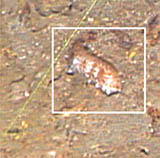Parastichopus regalis (Cuvier, 1817)
Royale cucumber| Native range | All suitable habitat | Point map | Year 2050 |

|
| This map was computer-generated and has not yet been reviewed. |
| Parastichopus regalis AquaMaps Data sources: GBIF OBIS |
Classification / Names Common names | Synonyms | CoL | ITIS | WoRMS
Holothuroidea | Synallactida | Stichopodidae
Environment: milieu / climate zone / depth range / distribution range Ecology
Benthic; depth range 5 - 800 m (Ref. 93433), usually 100 - 299 m (Ref. 93433). Subtropical; 56°N - 17°S, 83°W - 36°E
Distribution Countries | FAO areas | Ecosystems | Occurrences | Introductions
Atlantic and the Mediterranean: Antilles to Gulf of Mexico, north to Ireland to Angola and east to Turkey.
Length at first maturity / Size / Weight / Age
Maturity: Lm ? range ? - ? cm Max length : 35.0 cm TL male/unsexed; (Ref. 366)
Short description Morphology
Life cycle and mating behavior Maturity | Reproduction | Spawning | Eggs | Fecundity | Larvae
Main reference
References | Coordinator | Collaborators
Ramón, M., J. Lleonart and E. Massutí 2010 Royal cucumber (Stichopus regalis) in the northwestern Mediterranean: distribution pattern and fishery. Fish. Res. 105(1):21-27. (Ref. 93433)
IUCN Red List Status
(Ref. 130435: Version 2025-1)
CITES status (Ref. 108899)
CMS (Ref. 116361)
Threat to humans
Human uses
Fisheries: commercial
| FishSource |
Tools
More information
Max. ages / sizes
Length-weight rel.
Length-length rel.
Length-frequencies
Mass conversion
Abundance
Internet sources
BHL | BOLD Systems | CISTI | DiscoverLife | FAO(Publication : search) | Fishipedia | GenBank (genome, nucleotide) | GloBI | Gomexsi | Google Books | Google Scholar | Google | PubMed | Tree of Life | Wikipedia (Go, Search) | Zoological Record



